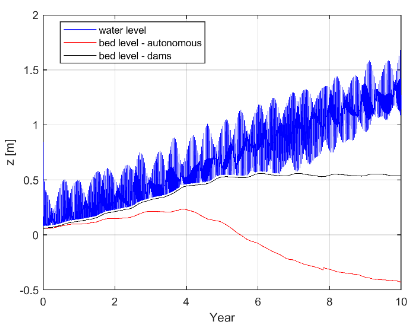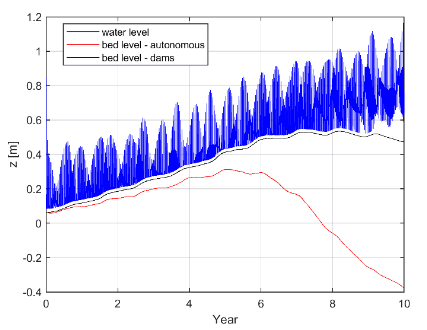B.P. Smits1, D.S. Van Maren1,2, B.K. Van Wesenbeeck1,2
1 Deltares, Marine & Coastal Systems,
2 TU Delft, Faculty of Civil Engineering and Geosciences
Introduction
The coastal zone of Demak district (Central Java, Indonesia) is suffering from severe erosion due to the replacement of mangrove forests with fish and shrimp ponds, embankment of rivers and land subsidence (up to 13 cm per year; caused by ground water extraction). To stop erosion, enhance accretion and restore the mangrove ecosystem, permeable bamboo structures are placed in the intertidal zone. These structures are designed to attenuate waves and create still water conditions suitable for sediment accretion. This study uses a process-based numerical model to assess the effectiveness of the implemented permeable structures under various scenarios of sea level rise and land subsidence.
Methods
A Delft3D Flexible Mesh model is used to simulate the morphodynamic development of the coastal zone under various scenarios. An existing model setup is improved and utilized to compare the 10-year autonomous development of the coast under various sea level rise and subsidence scenarios, for conditions with and without the implementation of permeable structures.
Results
The model results show that without permeable structures, most of the Demak coastal zone will erode and drown for all investigated scenarios of relative sea level rise. Implementing permeable structures enhances trapping of sediments, thereby increasing the bed level behind the structures. Most sediment is trapped behind these structures for the most extreme scenarios of relative sea level rise. The bed level behind the permeable structures will keep up with relative sea level rise until some threshold has been exceeded (Figure 1). From that point onwards the permeable structures can no longer trap sufficient sediment to keep up with relative sea level rise, resulting in partial drowning of the coast. This is mainly due to the large rate of land subsidence, which is responsible for 90% of the rate of relative sea level rise. Hence, small rates of subsidence and sea level rise already cause loss of coastal areas if no measures are implemented. However, although measures (such as permeable structures) can help in mitigating the effects of relative sea level rise, on the long run and with high rates of relative sea level rise, this effect does not persist.


Figure 1 Bed level development over time throughout the model simulation for different scenarios at observation points behind one of the permeable structures. The blue line indicates the tidal water level including relative sea level rise (on hydrodynamic timescale), the red line indicates the autonomous bed level development and the black line the bed level with permeable structures. Subpanels show the best-case scenario with rSLR of 8.2 cm/year (left) and worst-case scenario with rSLR of 13.6 cm/year (right).
I. Surname1*, F.N. Another-Surname2 , Y. Next-Surname2
1 University Name, Country; 2 Organization Name, Country
* Corresponding author: mail.name@organization.org


